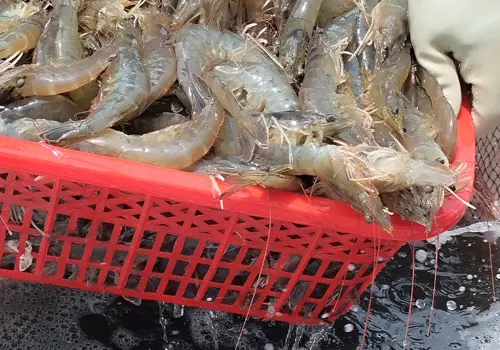
Fase Pembesaran
Pertumbuhan sehat melalui nutrisi dan manajemen tepat
Apakah Manajemen Anda Sudah Sesuai dengan Standar Kepadatan Tebar?
Bagaimana Memilih Pakan Pembesaran yang Tepat?
Bagaimana Cara Memantau Konsumsi Pakan Udang?
PERTANYAAN YANG SERING DIAJUKAN
Beberapa pertanyan penting dalam fase pembesaran
Udang akan dipanen sesuai dengan permintaan ukuran pasar atau ketika kapasitas tampung kolam sudah tercapai. Dalam kondisi ini, panen parsial dapat dilakukan untuk memberikan ruang bagi udang yang tersisa agar tumbuh lebih besar. Strategi ini dapat membantu meningkatkan harga jual dan efisiensi kolam. Pemberian pakan harus disesuaikan dengan kepadatan tebar, umur, dan ukuran udang. Menggunakan pakan yang ekonomis sangat penting untuk menjaga keuntungan, terutama ketika harga pasar sedang rendah.
Diskusikan kapasitas tampung kolam Anda bersama ahli kamiKualitas air penting untuk selalu dijaga agar tetap berada dalam kisaran optimal bagi udang. Pastikan suplai oksigen cukup dan kotoran udang tersaring dengan baik. Probiotik dapat membantu mengelola beban air seperti TAN (Total Ammonia Nitrogen) serta mencegah serangan penyakit. Gunakan probiotik sesuai dengan petunjuk pada produk. Penambahan probiotik ke dalam pakan udang juga dapat meningkatkan daya cerna dan penyerapan nutrisi.
Pembahasan lebih dalam terkait probiotik dalam budidaya udangDalam budidaya udang hiper intensif, pakan tidak hanya ditujukan untuk udang, tetapi juga untuk bioflok yaitu mikroba menguntungkan yang membantu menjaga kualitas air dan menyediakan pakan alami. Dukungan yang tepat terhadap sistem ini penting untuk stabilitas dan kesehatan udang. Pastikan lingkungan tetap seimbang dengan aerasi yang baik, pengaturan pakan yang tepat, dan penambahan karbon untuk menjaga bioflok tetap aktif dan efektif. Cara ini akan mendukung pertumbuhan optimal, kualitas air yang terjaga, serta efisiensi budidaya secara keseluruhan.
Kontak tim technical support kami untuk dukungan lapang